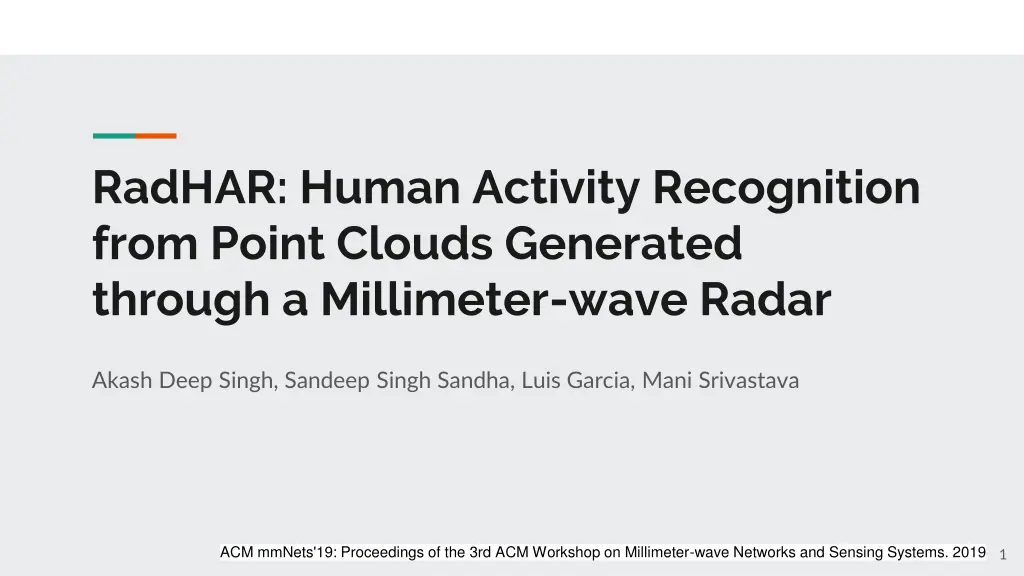
Human Activity Recognition from Millimeter-wave Radar Point Clouds
"Explore how human activity recognition is achieved using point clouds generated by millimeter-wave radar. This research presents a framework that leverages machine learning for accurate detection, overcoming challenges faced by traditional sensors and classifiers."
Uploaded on | 0 Views
Download Presentation

Please find below an Image/Link to download the presentation.
The content on the website is provided AS IS for your information and personal use only. It may not be sold, licensed, or shared on other websites without obtaining consent from the author. If you encounter any issues during the download, it is possible that the publisher has removed the file from their server.
You are allowed to download the files provided on this website for personal or commercial use, subject to the condition that they are used lawfully. All files are the property of their respective owners.
The content on the website is provided AS IS for your information and personal use only. It may not be sold, licensed, or shared on other websites without obtaining consent from the author.
E N D
Presentation Transcript
RadHAR: Human Activity Recognition from Point Clouds Generated through a Millimeter-wave Radar Akash Deep Singh, Sandeep Singh Sandha, Luis Garcia, Mani Srivastava ACM mmNets'19: Proceedings of the 3rd ACM Workshop on Millimeter-wave Networks and Sensing Systems. 2019 1
HAR (human activity recognition) Accurate human activity recognition (HAR) is the key to enable emerging context-aware applications that require an understanding and identification of human behavior. 2
Problems Ambient sensors and/or wearable sensors are proved to be effective to detect human behavior. The sensor data from cameras carry a significant amount of ambient information that may be of concern for privacy-sensitive applications. Not all of the people will wear wearable sensors with them. Less information-rich ambient sensors can also effectively infer human activities.(eg. wifi router) It is not robust beyond binary classification of two classes that are significantly different from each other. WiFi has a narrow band (when compared to the high bandwidth of a mmWave radar) and does not have sufficient range resolution to perform robust classification. Millimeter-wave (mmWave) Radar can promised not to exposing privacy information of subjects. Accurate activity classifiers is a challenge as low-cost millimeter-wave (mmWave) radar systems produce sparse and non-uniform point clouds. 3
Contributions Proposed a framework that performs human activity recognition using a pre-processing pipeline for point clouds generated by mmWave radar. Evaluated different machine learning approaches for human activity detection using point cloud. Generate a new point cloud dataset for human activity detection and make it available open- source along with the data processing, classifier training and evaluation code, and pre-trained classifiers. 4
Framework Overview Collects data from a mmWave radar that is monitoring a human The point cloud data is pre-processed before being fed into a HAR classifier.(eg. Voxelized, time window) 5
Dataset Collection Radar is mounted on a tripod stand at a height of 1.3m 5 different activities, These activities are: Walking, Jumping, Jumping Jacks, Squats and Boxing. The data is collected in a continuous periods of about 20 seconds, 93 minutes in total. 6
Data Pre-processing Voxelized: Time window: Create windows of 2 seconds (60 frames) having a sliding factor of 0.33 seconds (10 frames) Chosen based on the previous works. Converted the point clouds into voxels of dimensions 10x32x32. Dimensions is decided empirically by testing their performance 12097 samples in training and 3538 samples in testing. 7
Training with Different Classifier SVM MLP Bi-directional LSTM Time-distributed CNN + Bi-directional LSTM 8
Evaluation The SVM classifier has poor performance with test accuracy of 63.74%. The input to the SVM is not using the domain specific feature extraction approach. MLP classifier consists of the fully connected layers which doesn t assume anything about the input data and has test accuracy of 80.34%. Bidirectional LSTM classifier tries to learn the sequence of input data. It s performance is significantly better then the MLP with test accuracy of 88.42%. Time-distributed CNN + Bi-directional LSTM which has test accuracy of 90.47%. Time-distributed CNN learn the spatial features from the data. Bidirectional LSTM takes time into consideration. 9
Discussion and Future Research Spatial and temporal dependencies in point clouds. The reason why MLP classifier s performance is bad might be due to fact the fully connected layers in it makes no spatial and temporal assumption about the data. Time-distributed CNN + Bi-directional LSTM classifier assumes spatial and temporal dependency in the data and hence performs better. Limitations of voxelized representation Voxels result in significant increase in the required memory and computation. 10
Conclusion Deep learning classifiers can be directly trained on the time window voxel representation and can achieve test accuracy greater than 90%. Deep learning classifiers are able to learn the feature extraction transformation by directly training on the voxels. The classifiers which are designed to handle the spatial and temporal dependencies in data perform better the fully connected deep learning classifier. 11
